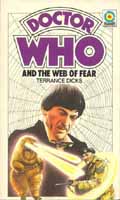The Web of Fear
Doctor Who and the Web of Fear

|
The Web of Fear |
Target novelisation Doctor Who and the Web of Fear |

|
| Author | Terrance Dicks |  |
| Published | 1976 | |
| ISBN | 0 426 11084 6 | |
| First Edition Cover | Chris Achilleos |
| Back cover blurb: Forty years the Yeti had been quiet. A collector's item in a museum. Then without warning it awoke - and savagely murdered. At about the same time patches of mist began to appear in Central London. People who lingered anytime in the mist were found dead, their faces smothered in cobwebs. The cobweb seeped down, penetrating the Underground System. Slowly it spread... Then the Yeti reappeared, roaming the misty streets and cobwebbed tunnels, killing everyone in their path. Central London was gripped tight in a Web of Fear... |
Awesome by Tim Roll-Pickering 19/1/04
Novelisations of Hartnell and Troughton stories were extremely rare in the 1970s, unless the original author had written them, so to find Terrance Dicks producing a second book from the period is a bonus, especially as the televised story The Web of Fear is one of the strongest and most memorable from the period.
Dicks had already produced the novelisation Doctor Who and the Abominable Snowmen and so his familiarity with the material helps no end (although he still makes a slight mistake with Victoria's origins, stating that she was rescued from nineteenth century London which could lead to continuity pedants burning the book). Much of the story goes unchanged, bar the deletion of the opening sequence which resolves the cliffhnager from The Enemy of the World by showing how the Doctor, Jamie and Zoe save themselves from being sucked into space like Salamander, but there are many subtle additions that enhance the story immensely. We get a brief resume of the events in Tibet and then an explanation as to how Travers changed himself from an anthropologist to a world renowned professor of electronics. Most spectacularly of all Dicks takes the opportunity to add some scenes involving the Doctor to the second episode of the story, whereas in the televised version the Doctor is missing in action to allow Patrick Troughton a week's holiday, and we get to see "as historic an encounter as that between Stanley and Doctor Livingstone" when the Doctor encounters Colonel Lethbridge-Stewart. Onscreen this was, with hindsight, an unfortunate ommission, but here we are told of the significance of the moment and throughout the book little touches are added which show how the Doctor and the Colonel's mutual trust expands as they realise how they need each other.
A strong television story does not automatically mean that the novelisation will remain effective, but Dicks pulls out all the stops to really bring this tale to life. An attempt is made to get away from some of the story's stereotypes, with the colonel's thought that although Evans is a coward the Welsh usually make good soldiers, whilst Julius Silverstein becomes Emil Julius and is far less extreme than onscreen. The descriptions in the book frequently serve to bring the story to life, with Dicks once again depicting the Troughton Doctor with ease. Above all there is a real sense of terror which pervades this novelisation, making the characters seems truly isolated and the Intelligence seem truly threatening.
There are a few minor faults with the book, most notably the failure to clear up just what did happen to the Doctor's fragment of the Web which mysteriously vanishes from Evans' tin (an oversight also in the televised version though it stands out more clearly here), whilst no attempt is made to show what happens to Harold Chorley after he sets out to try and find the TARDIS, despite his being a key suspect to be the Intelligence's agent. But these are little problems carried over from the television story. Otherwise this is an extremely strong book and easily one of the best Targets of all. 10/10